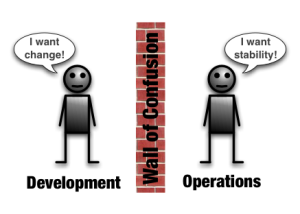Processes
The second item to tackle when adapting DevOps principles is to look at the processes. In the last 10 - 20 years the agile movement pushed into a lot of industries. This also plays a major role in the DevOps movement. Deploying new things frequently and adapting to change, is what a lot of companies hope when starting to implement DevOps. Yet, the one thing that always seems to be the blocker is the operation side, which handles keeping the services and systems alive. Here the DORA (DevOps Research and Assessment) Team came up with metrics, that one can measure to ensure that you keep a healthy balance between new features and stability.
Automation and Standardization
One central piece when adapting DevOps is to put automation in place. It's something that I like, and that also helps to speed up things a lot. Yet, one thing that gets a lot of times forgotten is to first agree on a standard. Computers and especially automation scripts are not as flexible as humans. And it's very expensive to account for all the special cases when implementing automation. So you first have to look and your existing software and infrastructure and decide to go for one standard. This can range from programming languages, and CI/CD tools, to cloud services. I know that especially for technical enthusiasts that's a hard pill to swallow. But in my opinion, this is a very important one. Don't keep all the snowflakes and special cases and put in place automation for them. Instead, spend time putting a standard in place and implementing the automation for this standard. This will save you in the long run.
The twelve-factor app
One standard for writing software, that is being used in the area of Software-as-a-Service (SaaS) is the twelve-factor app. Implementing these best practices for your application helps you in adopting the DevOps principles. It also gives you clear interfaces to use for example for logging, networking, or environment configuration. This is especially useful when trying to bridge the gap between the developer tasks and IT operations tasks.
Handoff between Dev and Ops
In the What is DevOps? section, I mentioned the wall of confusion, and that the goal is to get rid of it. But, to get rid of it, you need to put a process in place, that is doing the tasks that before were done by developers and operations people and automating these. But how do you do this?

Before DevOps was a thing, we already build and deployed software. The separation was clear and the developers were responsible for writing the code. As well as for creating the packages and in the best case writing the documentation what was needed to deploy the app.
Then the package as well as the documentation was handed over to the operations team, which was responsible for providing the infrastructure. This contained everything from ordering hardware, wiring the servers, up to installing and configuring the operating system. Including setting up these systems for high availability and business continuity. On top of these, the software was then being installed.
Both sides, the developers and operation people have their own processes for each of their tasks. With DevOps one challenge is to rework both sides and put also the bridge between processes in place. And like so many times in IT there is not one correct way of doing this. Instead you have to decide what works best for your situation. There are many variables, that you need to account for. For example, is the software written in house, or provided by a third-party vendor. Or do you want to have the app deployment code part of the app code or infrastructure code. I have seen many different ways, and different approaches working for different teams. As well as, one approach working for one team, but not for another team. This means, it depends on the application, the teams, and the processes already in place. But one of the things all had in common, was a high degree of automation.